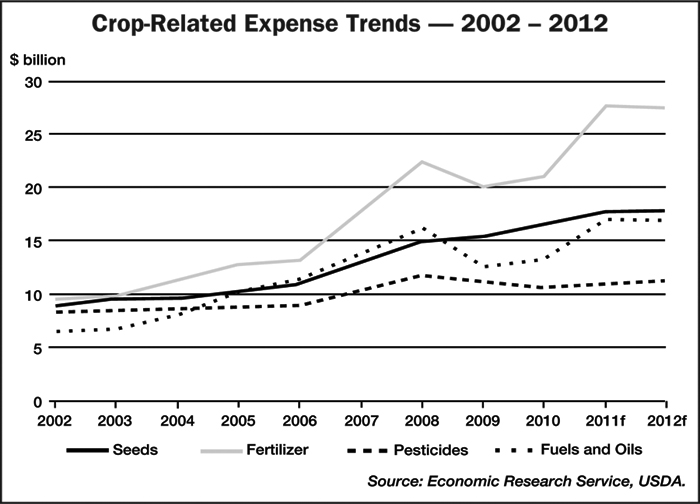After rapid rises in costs since 2002, total farm production expenses are forecast to rise $12.5 billion (3.9%) this year. This increase is far less than the $35.7 billion (12.5%) growth projected in 2011. The growth in crop-related expenses (seeds, fertilizer, pesticides), livestock-related expenses (feed, livestock/poultry purchases), and fuel and oil expenses are all expected to slow following a decade of very rapid expansion, though recent rises in diesel expenses may change this outlook somewhat.
According to USDA’s “Farm Income and Costs: 2012 Farm Sector Income Forecast,” which was updated in February, the slowdown in the rise in crop-related expenses is dramatic. These expenses have been rising rapidly since 2002 with a downturn only in 2009.The increases have been driven by increases in input prices. The rise in prices in 2012 is projected to be small.

|
Heavy Users
The other factor determining crop expenses — the number of planted acres — is expected to be down 1.3% in 2012. Further, acreage of heavy users of these inputs will be constant (corn) or down (soybeans, cotton). Wheat is the only major crop that shows a significant projected increase in acreage, and it does not use these inputs as heavily as other crops.
Two major seed producers have already said that seed prices will rise 5-10% in 2012. They justify this increase by citing improved yields and stronger disease and pest resistance, which they believe will help producers to optimize returns. Availability should not be a problem.
The annual average prices paid index for fertilizer rose nearly 30% in 2011, and some prices rose to historically high levels. In 2012, the prices- paid index is forecast to rise by about only 1.5%.
To the extent that fertilizer prices are tied in part to commodity prices, they are both likely to abate in 2012. Availability of nitrogen-based fertilizers might be a problem, however, which could lead to a greater rise in prices for these products. At present, agricultural chemical prices are projected to increase by roughly 6% in 2012. Agricultural economists at Purdue Univ. forecast a rise of 12-16% in total variable costs for producing corn, soybeans and wheat.
Fuel Prices Dropping?
While USDA is projecting prices for diesel and gasoline to be flat during the year, the agency adds this market is volatile, however, so it is difficult to pinpoint where prices will go during the year.
According to the USDA report, the slowdown in the rise in fuel and oil prices is as striking as that in the major crop-related expenses.
The annual average prices-paid index for fuels and oils registered eight double-digit percentage increases starting in 2003, with only one precipitous drop in 2009. In 2012, that index is projected to rise 2.5%, mainly as a result of a 2% hike in the Refiner Acquisition Cost (RAC).
On the other hand, in its January 13 report, the U.S. Energy Information Admn. (EIA) said, if 2011 trends for the price of fuel hold, farmers may be paying significantly higher prices for diesel by the time spring planting begins. Diesel pricing continued to edge up in early 2012.
The average price paid for gasoline and diesel during 2011 never fell below $3 per gallon, marking the first time the national pump price for both transportation fuels topped $3 per gallon throughout a calendar year, according to the EIA. Crude oil, which accounted for more than 60% of the cost of making the fuels, was the main reason prices were higher at the pump. At the same time, the difference between the prices of gasoline and diesel reached its widest level on record due mostly to stronger demand for diesel.
The lowest price for diesel fuel in 2011 was $3.33 per gallon during the first two weeks of January, while the highest price was $4.12 per gallon on May 2, during a six week period when diesel averaged more than $4 per gallon. The national pump price for diesel has not been under $3 per gallon since September 27, 2010.
As of March 12, the EIA reports the average price for diesel in the U.S. was $4.123, up 0.215 from a year ago.
Overall Increases
The three manufactured inputs — fertilizer, pesticides and fuels and oils — together are forecast to be $56 billion in 2012, putting them $655 million (1.2%) higher than their level in 2011.
This increase is miniscule compared to the $10.5 billion (23.4% per- cent) rise in 2011, according to USDA. In 2012, these expenses will constitute 16.8% of total expenses, slightly less than in 2011.





